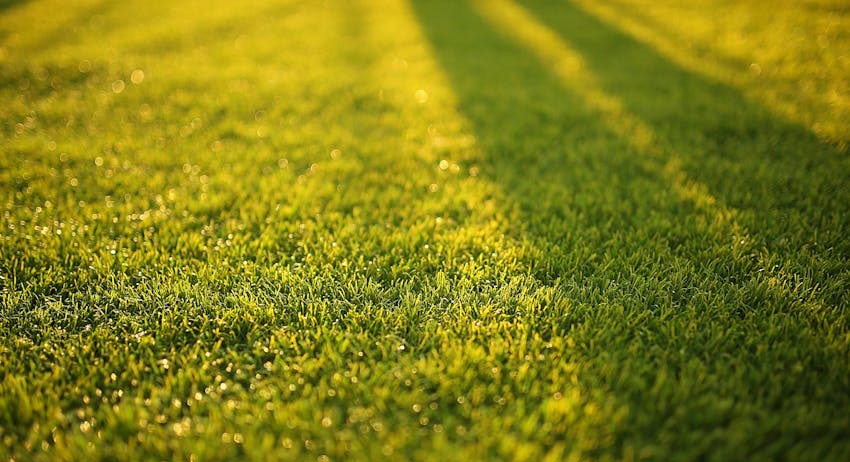When is the Best Time to Fertilize Your Lawn?
According to the University of Illinois Agriculture Division, the best time to fertilize your lawn is spring (mid to late April) when the soil temperature reaches about 55°F. This is usually the time when the grass shifts from dormancy to its optimum growth.
While spring is often considered the go-to season, the ideal timing can vary depending on your local climate and the type of lawn grass. In warmer, southern-like climates, where bermudagrass, zoysiagrass, and St. Augustinegrass (warm-season grasses) are commonly used, the majority of fertilizing is most effective late spring through summer, supporting active growth during their peak season.
Conversely, cool-season grasses such as tall fescue and Kentucky bluegrass benefit most from feeding in spring and fall when they’re building root strength and storing nutrients.
Avoid fertilizing cool-season grass in winter because the grass doesn’t absorb proper nutrients and doesn’t actively grow.

What is Lawn Fertilization?
Lawn fertilization is the process of adding nutrients, such as nitrogen (N), phosphate (P), and potassium (K), to the soil for the optimal and healthy growth of your lawn. The Oklahoma State University Agriculture Division advises an N-P-K ratio of 3-1-2 or 4-1-2 for lawns, where the ratio of nitrogen is suggested to be comparatively larger because it provides a greener look to your lawn. The nutrients’ ratio is generally mentioned on the fertilizer’s bag.
There are two common types of fertilizers: granular and liquid. Richard L. Parish, a professor at the Louisiana State University Agriculture Division, states that granular fertilizer is the best option for lawns when it’s evenly distributed with a drop or broadcast spreader. On the other hand, liquid fertilizers that are sprayed in the soil can have risks of dermal absorption, drift, and contaminated mixing areas.
Proper lawn fertilization strengthens root systems, improves drought tolerance, and helps turf resist pests and diseases. To get the best results, it’s important to follow the application rates on the product label, which will be the amount of minerals (macronutrients and micronutrients) required for the ideal lawn fertilization, recommends the Oklahoma State University Agriculture Division.
Over-fertilizing can burn the grass, waste money, and contribute to runoff that pollutes streams and lakes.
For urban areas, fertilization takes on extra importance. City lawns often face unique challenges like compacted soil from foot traffic, limited root space, and shaded spots between buildings. In such conditions, the right nutrient balance can make the difference between thin, patchy grass and a healthy, resilient lawn.
Use slow-release fertilizers (granular), water wisely, and avoid application before heavy rain, which will help your lawn grow actively while keeping local waterways clean.
When Is the Best Time to Fertilize Warm-Season Grasses?
For warm-season grasses in regions with extended summer heat, the optimal fertilization time begins with post-dormancy, which is late-May to early-June and continues through August to mid-September (with slight possibility), according to the Kansas State University Research Division. This timing supports active growth because the soil temperature is warming up and recovering from winter dormancy.
The appropriate fertilization schedule matters because applying nutrients earlier can result in wasted fertilizer since grasses aren’t yet actively absorbing minerals. On the other hand, fertilizing your lawn too late can produce fresh grass during times when it’s supposed to be slowing down and getting ready for the cold.
This new grass won’t have enough time to mature and develop its natural protections before winter dormancy begins, which will make it vulnerable to cold damage and lawn diseases during the fall and winter.
Therefore, it’s essential to properly schedule your warm-season grass fertilization.
Grass-Specific Timing:
- Bermudagrass – April to August with quick release and April, June, and August with slow release (lawn calendar)
- Zoysiagrass – May, June, July, and August (lawn calendar)
- St. Augustinegrass – May, June, July, and August (lawn calendar)

When Is the Best Time to Fertilize Cool-Season Grasses?
For cool-season grasses in regions with intense summer heat and humidity, the ideal fertilization window is in fall with small amounts in spring and rarely in summer. According to the University of Kentucky Agriculture Division, this timing strengthens the root system, improves winter hardiness, supports early spring green-up, and reduces disease and weed pressures.
A spring fertilization is only recommended if the fall feeding was missed, and even then, it should be at half the usual rate, applied in late May to early June to avoid overly encouraging leafy growth that leads to weed competition and mowing stress.
Grass-Specific Timing:
- Tall Fescue – October, December, March, and May
- Kentucky Bluegrass – October, December, March, and May
- Perennial ryegrass – October, December, March, and May
Although cool-season turfgrasses do not need as much fertilizer as warm-season grasses, they can still benefit from fertilizing in fall, with small amounts in the spring, and with a slight possibility of fertilizing in summer. If the fall fertilization was missed, apply a half-rate feeding in spring to gently boost green-up without overstimulating shoot growth.
What Happens If You Fertilize at the Wrong Time?
Fertilizing at the wrong time can stress your lawn, reduce nutrient uptake, increase disease risk, and waste both time and money.
Key Risks of Fertilizing at Unsuitable Times:
- Stresses your lawn – Applying fertilizer during dormancy or extreme temperatures can damage turf. Purdue Agriculture experts advise against late-fall feeding on cool-season grasses when soil temperatures fall below 40°F, as turf growth has essentially stopped and nutrients will not be used effectively.
- Reduces nutrient uptake – If grass roots aren’t actively growing, applied nutrients remain unused and may wash away.
- Increases disease risk – Applying during extreme heat, drought, or humid periods can stimulate weak growth, which encourages fungal diseases like brown patch and take-all root rot. Better Homes & Gardens (BHG) cautions that improper timing combined with excessive nitrogen encourages these turf diseases.
- Wastes time and money – Fertilizer applied when grass is not actively growing provides little to no benefit, meaning the cost of your product, water, and labor is lost. Additionally, improperly timed applications contribute to runoff, which can harm local ecosystems.
By following research-backed guidelines for your lawn fertilization, you ensure nutrients are delivered when turf can use them most efficiently, resulting in a healthier, more resilient lawn and a reduced environmental footprint.
When Is the Best Time to Fertilize Your Lawn in Oklahoma?
For cool-season grasses like tall fescue and Kentucky bluegrass, the prime time to fertilize is October, when temperatures are in the 60–70°F range. Feeding during this window helps the grass store energy in its roots and crowns, boosting winter survival and ensuring a strong spring green-up.
If your lawn needs a second application for maintaining the lawn, apply a lighter dose in early March or May. This encourages recovery from winter dormancy. Keep nitrogen rates low to avoid rapid growth before summer heat stress, a tip backed by Oklahoma State University turf research.
For warm-season grasses like Bermuda, Zoysia, and St. Augustine, start fertilizing in late April through early August. The key is to begin when the lawn has fully greened up and soil temperature is consistently above 65°F. This ensures nutrients go straight into active root and shoot growth.
Finally, the nitrogen and other mineral fertilizer application of warm-season lawns in Oklahoma must be stopped 6–8 weeks before the average first frost (15 September). This will prevent the new grass growth from being damaged by cold weather.
